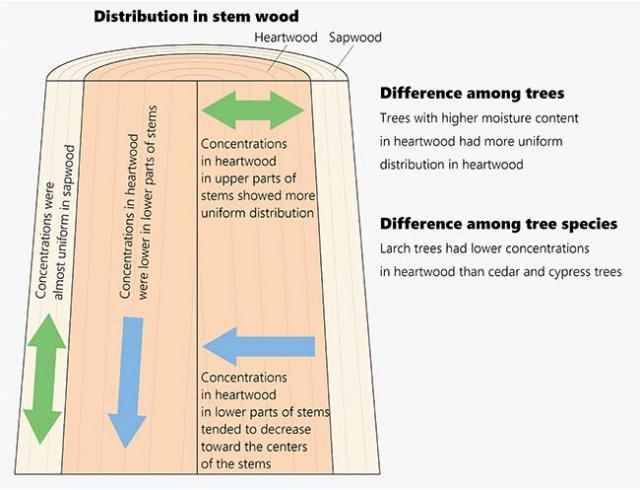Home > Research > Research Results > Research Results 2020 > Distribution of radiocesium in stem wood differs by species and vertical position, diameter, and moisture content of stem
Update:July 20, 2020
Main content starts here.
Distribution of radiocesium in stem wood differs by species and vertical position, diameter, and moisture content of stem
| Article title |
Tracing radioactive cesium in stem wood of three Japanese conifer species 3 years after the Fukushima Dai-ichi Nuclear Power Plant accident. |
|---|---|
| Author (affiliation) |
Shinta Ohashi (a), Katsushi Kuroda (a), Takeshi Fujiwara (a), Tsutomu Takano (b) (a) Department of Wood Properties and Processing, FFPRI, Tsukuba, Ibaraki, Japan. (b) Center for Forest Restoration and Radioecology, FFPRI, Tsukuba, Ibaraki, Japan. |
| Publication Journal |
Journal of Wood Science, 66, 44, June 2020 DOI:10.1186/s10086-020-01891-2( External link ) |
| Content introduction |
Radioactive cesium (137Cs) dispersed into the environment by the Fukushima Dai-ichi Nuclear Power Plant accident was absorbed into trees through foliage or is still being absorbed through roots, and transferring to stem wood. Although it is known that the distribution of 137Cs within stem wood is non-uniform, it is unclear how it varies among tree species or tree size and how it changes with time. In this study, we investigated the distribution of 137Cs activity concentration in stem wood of Japanese cedar, cypress, and larch (ca. 50 years old, 20–50 cm in diameter at breast height) felled 3 years after the accident. The distribution of 137Cs activity concentration within sapwood (outer part of stem wood) was almost uniform, whereas that within heartwood (inner part of stem wood) was mostly non-uniform. Statistical analysis suggested that the distribution pattern in stem wood depends on the species, vertical position within the stem, diameter of heartwood, and moisture content of heartwood (summarized in the Figure below). We infer that such differences have arisen from differences in the transport property of living cells in stem wood and differences in the contamination pathway after the accident. In addition to the results above, comparisons of distribution patterns between 137Cs and naturally-existing 133Cs revealed that not as much 137Cs had transferred to inner parts of heartwood compared with 133Cs, suggesting that the transfer of 137Cs to inner parts of heartwood may progress further. Follow-up monitoring will enable us to understand how rapidly the transfer of 137Cs to the heartwood progresses and when it reaches an equilibrium state, and to contribute to the prediction of 137Cs contamination of stem wood.
Figure: Distributions of 137Cs activity concentration in stem wood 3 years after the Fukushima Dai-ichi Nuclear Power Plant accident. |
Copyright © Forest Research and Management Organization. All rights reserved.

